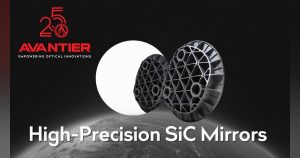Unlocking the Power of Off-Axis Parabolic (OAP) Mirrors: A Guide to Advanced Optical Systems
If you’re designing an advanced optical system and aim to use cutting-edge solutions for fields like astronomy, laser optics, spectroscopy, and biomedical imaging, Off-Axis Parabolic (OAP) mirrors are the way to go. In this insightful guide inspired by Avantier’s webinar, we delve into the exceptional benefits of OAP mirrors, critical design considerations, their real-world applications, and their crucial role in next-gen optical systems.
What Are Off-Axis Parabolic (OAP) Mirrors?
Envision a satellite dish, sliced and polished to an extraordinary degree of precision. OAP mirrors are crafted from a larger parabolic surface, reflecting light to or from an offset focal point. This ingenious design modification opens up remarkable benefits for modern optical engineering. OAP mirrors offer the advantage of compact design, simplified optical setups over refractive options, and accuracy across a vast spectral range.
The Key Principles
- Parabolic Reflection: A true parabolic mirror focuses parallel light perfectly, free of spherical aberration. OAPs maintain this feature while placing the focus off the central axis.
- Off-Axis Geometry: Removing central obstructions allows for unobstructed focal access—ideal for intricate setups.
- Reflection, Not Refraction: OAP mirrors rely solely on reflection, thus avoiding chromatic aberrations seen in glass lenses.
OAP vs. On-Axis Parabolic Mirrors: Understanding the Differences
| Feature | On-Axis Parabolic Mirror | Off-Axis Parabolic Mirror (OAP) |
|---|---|---|
| Focus Position | Centered, along axis | Offset, to the side |
| Central Obstruction | Yes | None—open access |
| Aberration Correction | No spherical, some coma | No spherical, some coma if misaligned |
| Application Flexibility | Limited | Very high |
| Achromatic Performance | Yes | Yes |
Enabling Next-Generation Optical Design with OAP Mirrors
1. Precision Beam Control
The core ability of OAP mirrors is managing light with high precision, providing perfect convergence and collimation of beams, zero chromatic aberration, and minimized spherical aberration.
2. Space-Efficient Layouts
The off-axis design provides open focus access, allows for compact optical paths, and provides flexibility in directing beams accurately where needed.
Crucial Design Parameters Explained
Parent Focal Length & Off-Axis Distance
Defined by the original paraboloid’s focal length, which influences the mirror’s power, and the distance showing how far off-axis the mirror is cut.
Off-Axis Angle
This ranges significantly (15° to 45°), influencing mounting method and space needs around the focal area.
Clear Aperture
The clear aperture is the effective ‘window’ for light entry/exit—essential for beam size compatibility.
Surface Quality
Surface quality is critical, typically specified with less than 1/3λ surface accuracy for reducing scatter.
Advantages of Choosing OAP Mirrors
- Elimination of chromatic aberration
- No central obstruction
- High power handling capabilities
- Broad range adaptability: from deep UV to far-IR
Real-World Applications: Lasers, Astronomy, and Beyond
1. Laser Beam Applications
Custom OAPs manage to focus high-energy lasers for applications in physics and medicine.
2. Adaptive Optics in Astronomy
Telescopes use OAPs to steer and focus starlight without distortions.
3. Spectroscopy and Metrology
OAPs deliver distortion-free beams for materials testing and analysis.
Manufacturing and Customization: Precision in Partnership
Advanced OAP mirrors are produced with state-of-the-art techniques, ensuring extremely accurate surfaces. Partnering with specialists like Avantier ensures custom solutions meet your specific needs.
Avoiding Common Pitfalls: Expert Tips
- Ensure light is parallel to the optical axis to avoid comatic aberration.
- Select the correct off-axis angle for your mounting and access needs.
The Human Element: Innovation through Collaboration
Optical advancements hinge on partnerships with industry experts. Solutions from companies like Avantier highlight the collaboration needed to achieve optical breakthroughs in fields from astronomy to medtech.













